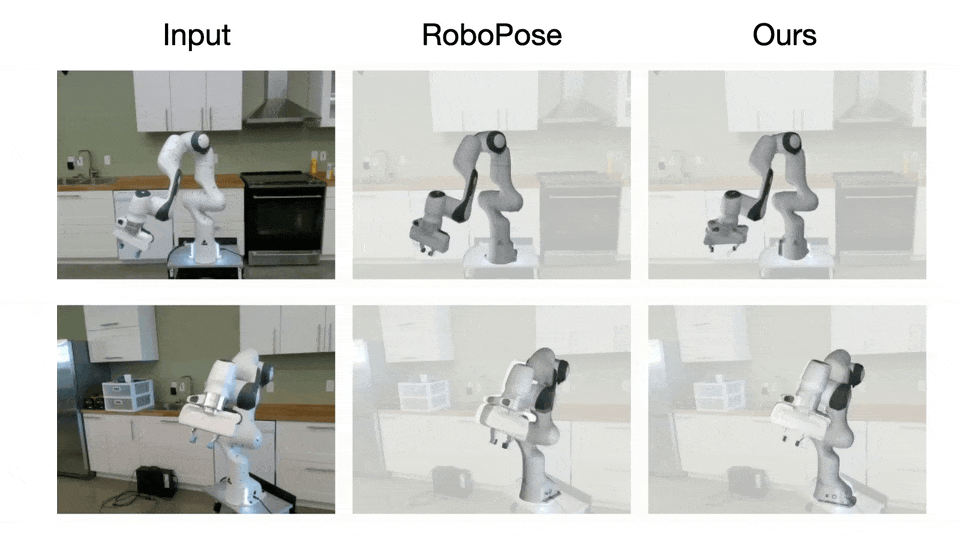This is the official PyTorch implementation of the paper "Real-time Holistic Robot Pose Estimation with Unknown States". It provides an efficient framework for real-time robot pose estimation from RGB images without requiring known robot states.
This project's dependencies include python 3.9, pytorch 1.13, pytorch3d 0.7.4 and CUDA 11.7. The code is developed and tested on Ubuntu 20.04.
pip install torch==1.13.1+cu117 torchvision==0.14.1+cu117
pip install -r requirements.txt
conda install pytorch3d=0.7.4 # from https://anaconda.org/pytorch3d/pytorch3d/filesIn our work, we use the following data and pretrained model:
- The DREAM datasets consisting of both real and synthetic subsets, placed under
${ROOT}/data/dream/$. - The URDF (Unified Robotics Description Format) of robot Panda, Kuka and Baxter, placed under
${ROOT}/data/deps/$. - The pretrained HRnet backbone for pose estimation, placed under
${ROOT}/models/$. - The openly available foreground segmentation model of 4 real datasets of Panda from CtRNet, placed under
${ROOT}/models/panda_segmentation/$.
You can download the data and models through provided links. When finished, the directory tree should look like this.
${ROOT}
|-- data
|-- dream
| |-- real
| | |-- panda-3cam_azure
| | |-- panda-3cam_kinect360
| | |-- panda-3cam_realsense
| | |-- panda-orb
| |-- synthetic
| | |-- baxter_synth_test_dr
| | |-- baxter_synth_train_dr
| | |-- kuka_synth_test_dr
| | |-- kuka_synth_test_photo
| | |-- kuka_synth_train_dr
| | |-- panda_synth_test_dr
| | |-- panda_synth_test_photo
| | |-- panda_synth_train_dr
|-- deps
| |-- baxter-description
| |-- kuka-description
| |-- panda-description
|-- models
|-- panda_segmentation
| |-- azure.pth
| |-- kinect.pth
| |-- orb.pth
| |-- realsense.pth
|-- hrnet_w32-36af842e_roc.pth
We train our final model in a multi-stage fashion. All model is trained using a single NVIDIA V100 with 32GB GPU. Distributed training is also supported.
We use config files in configs/ to specify the training process. We recommend filling in the exp_name field in the config files with a unique name, as the checkpoints and event logs produced during training will be saved under experiments/{exp_name}. The correspondent config file will be automatically copied into this directory.
Firstly, pretrain the depthnet (root depth estimator) for 100 epochs for each robot arm:
python scripts/train.py --config configs/panda/depthnet.yaml
python scripts/train.py --config configs/kuka/depthnet.yaml
python scripts/train.py --config configs/baxter/depthnet.yamlWith depthnet pretrained, we can train the full network for 100 epochs:
python scripts/train.py --config configs/panda/full.yaml
python scripts/train.py --config configs/kuka/full.yaml
python scripts/train.py --config configs/baxter/full.yamlTo save your time when reproducing results of our paper, we provide readily-pretrained depthnet model weights for full network training. To use them, you can modify the configs/{robot}/full.yaml file by filling in the pretrained_rootnet field with the path of the downloaded .pk file.
We employ self-supervised training for the 4 real datasets of Panda.
Firstly, train the model on synthetic dataset using configs/panda/self_supervised/synth.yaml for 100 epochs. Be sure to fill in the pretrained_rootnet field with the path of the pretrained Panda depthnet weight in advance.
python scripts/train.py --config configs/panda/self_supervised/synth.yamlThe training process above saves checkpoints for 4 real datasets for further self-supervised training (e.g. experiments/{exp_name}/ckpt/curr_best_auc(add)_azure_model.pk).
When finished training on synthetic data, modify the configs/panda/self_supervised/{real_dataset}.yaml file by filling in the pretrained_weight_on_synth field with the path of the correspondent checkpoint. Then start self-supervised training with:
python scripts/train.py --config configs/panda/self_supervised/azure.yaml
python scripts/train.py --config configs/panda/self_supervised/kinect.yaml
python scripts/train.py --config configs/panda/self_supervised/realsense.yaml
python scripts/train.py --config configs/panda/self_supervised/orb.yamlTo evaluate models, simply run:
python scripts/test.py --exp_path {path of the experiment folder} --dataset {dataset name}
# e.g. python scripts/test.py -e experiments/panda_full --dataset panda_synth_test_drNote that each model is presented in a folder containing ckpt/, log/ and config.yaml. After running test script, result/ will be generated inside the folder.
You can download our final models from Google Drive and evaluate them yourself.
If you use our code or models in your research, please cite with:
@article{ban2024real,
title={Real-time Holistic Robot Pose Estimation with Unknown States},
author={Ban, Shikun and Fan, Juling and Zhu, Wentao and Ma, Xiaoxuan and Qiao, Yu and Wang, Yizhou},
journal={arXiv preprint arXiv:2402.05655},
year={2024}
}This repo is built on the excellent work RoboPose and CtRNet. Thank the authors for releasing their codes.





